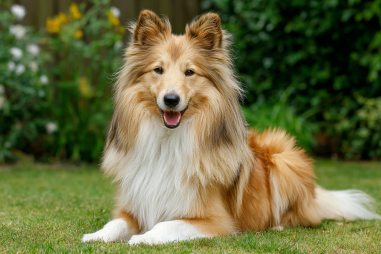Shetland Sheepdogs, affectionately known as Shelties, are beloved for their striking appearance and affectionate nature. One challenge that owners often face is managing their Sheltie’s shedding and keeping their beautiful coat in top shape throughout the year. Shelties have a double coat that naturally sheds seasonally, which means their grooming needs change depending on the time of year. By understanding shedding patterns and applying the right grooming and care techniques, you can keep your Sheltie’s coat healthy, shiny, and minimize the mess around your home. In this guide, we’ll explore practical tips and advice for effectively managing Shetland Sheepdog shedding and coat care.
Shedding Patterns in Shelties
Shetland Sheepdogs possess a dense double coat made up of a soft undercoat and a longer, harsher topcoat. This setup is designed to protect them from harsh weather, but it also means they go through seasonal shedding cycles to prepare for changing temperatures. Shelties typically shed more heavily in the spring and fall. In spring, they shed their thick winter undercoat to cool down during warmer months, while in the fall, they shed the lighter summer coat in preparation for winter.
The shedding process can last several weeks and during these times, you’ll likely find loose fur not only on your Sheltie but around your home as well. Outside of these seasons, Shelties shed moderately but consistently. Recognizing these patterns helps you plan extra grooming sessions around peak shedding periods to keep shedding under control.
Seasonal Grooming Routines
Adjusting your grooming routine to match the seasons is key to managing your Sheltie’s coat effectively. During heavy shedding seasons—spring and fall—it’s advisable to groom your Sheltie daily. This routine helps remove loose fur before it can spread around your home and prevents mats from developing.
In the milder shedding months, grooming two to three times a week suffices to maintain coat health and appearance. Regular brushing also stimulates natural oils in the skin, promoting a healthy and shiny coat. Keep an eye out for signs of skin irritation or dryness, as these might require adjustments to your grooming methods or frequency.
Tools to Reduce Shedding
Using the right grooming tools can make a significant difference when managing Sheltie shedding and coat care. Here are some recommended tools:
- Undercoat rake: Designed specifically to reach the dense undercoat and remove loose fur without damaging the topcoat.
- Slicker brush: Useful for detangling and smoothing the coat, especially in the longer fur areas.
- Pin brush: Gentle on the coat and great for finishing touches and general brushing.
- Deshedding tool: Tools like the Furminator are effective for reducing shedding by capturing loose hair directly from the undercoat.
Remember, using these tools gently and consistently is vital to avoid irritating your Sheltie’s skin.
Bathing Frequency Impact
Bathing your Sheltie properly can greatly impact their coat health and shedding. Generally, Shelties don’t need frequent baths—about once every six to eight weeks is sufficient unless they become particularly dirty. Overbathing can strip natural oils from their coat and skin, leading to dryness and increased shedding.
When bathing, use a high-quality dog shampoo formulated for double-coated breeds to nurture the skin and coat. Rinse thoroughly to remove all shampoo residues, as leftover product can cause itching and dandruff. After a bath, ensure you dry their coat thoroughly to prevent moisture from lingering in the dense undercoat, which can lead to skin infections or matting.
Nutritional Support for Coat Health
A healthy diet plays a fundamental role in maintaining a vibrant, well-conditioned coat. Shelties that receive proper nutrition tend to have less excessive shedding and healthier skin. Look for dog foods that contain:
- High-quality proteins to support hair follicle strength.
- Omega-3 and omega-6 fatty acids, which help reduce dryness and inflammation.
- Vitamins such as vitamin E and biotin that support skin and coat health.
Supplements can also be considered but consult your veterinarian before adding any new vitamins or oils to your Sheltie’s diet to ensure they benefit from them safely.
Handling Mats and Tangles
Shelties have a thick, long coat that is prone to mats and tangles, especially if shedding hair is left unattended. Mats can cause discomfort, skin irritation, and even infection if not addressed promptly. Preventing mats starts with regular brushing to keep fur smooth and free of debris.
If you do find mats, approach them carefully:
- Use a slicker brush or a mat splitter to gently work through tangles, starting at the edges and working inward.
- If mats are dense and close to the skin, consider using detangling spray to soften the hair before brushing.
- In extreme cases, a professional groomer may need to trim or shave severe mats to avoid hurting your dog.
Regular grooming is crucial to reducing mat formation and keeping your Sheltie comfortable.
Home Cleaning Tips for Shedding
Managing Sheltie shedding isn’t just about grooming your dog; it also involves keeping your home clean. Here are some strategies to handle the fur that inevitably floats around:
- Vacuum frequently: Use a vacuum cleaner with strong suction and a brush attachment designed for pet hair.
- Use lint rollers: Keep lint rollers handy to quickly pick up hair from furniture and clothing.
- Furniture covers: Protect sofas and chairs with washable covers that can be easily cleaned.
- Air purifiers with HEPA filters: These can help reduce airborne pet dander and hair, improving air quality.
- Designate dog-friendly zones: Limiting shedding to certain areas can make cleanup more manageable.
Putting Together a Shedding Management Plan
Effectively managing your Sheltie’s shedding requires a comprehensive plan tailored to your pet’s needs and your lifestyle. Here’s a simple strategy to follow:
- Identify shedding seasons: Increase grooming frequency during peak shedding times in spring and fall.
- Groom consistently: Brush your Sheltie several times a week with appropriate tools to remove loose hair and prevent tangles.
- Regular baths: Bathe every 6-8 weeks with a quality shampoo suitable for double coats, avoiding overbathing.
- Feed for coat health: Provide balanced nutrition rich in fatty acids and vitamins.
- Monitor coat condition: Address mats promptly and seek professional grooming if necessary.
- Maintain a clean home: Use vacuuming, lint rollers, and designated dog spaces to reduce hair buildup.
Following this plan will not only help control shedding but will also enhance your Sheltie’s comfort and well-being, allowing you to enjoy their company without being overwhelmed by loose hair.
With a little effort and mindfulness, managing Shetland Sheepdog shedding and coat care can become a routine that benefits both you and your furry friend. By staying proactive through seasonal grooming, feeding a proper diet, and keeping your home tidy, your Sheltie will thrive with a lustrous coat and minimal shedding headaches year-round.







